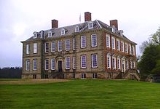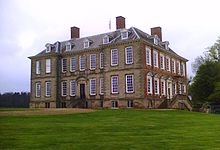
Stanford Hall
Encyclopedia

Stately home
A stately home is a "great country house". It is thus a palatial great house or in some cases an updated castle, located in the British Isles, mostly built between the mid-16th century and the early part of the 20th century, as well as converted abbeys and other church property...
in Leicestershire
Leicestershire
Leicestershire is a landlocked county in the English Midlands. It takes its name from the heavily populated City of Leicester, traditionally its administrative centre, although the City of Leicester unitary authority is today administered separately from the rest of Leicestershire...
, England
England
England is a country that is part of the United Kingdom. It shares land borders with Scotland to the north and Wales to the west; the Irish Sea is to the north west, the Celtic Sea to the south west, with the North Sea to the east and the English Channel to the south separating it from continental...
, near the village of Stanford on Avon (which is in Northamptonshire) and the town of Lutterworth
Lutterworth
Lutterworth is a market town and civil parish in the Harborough district of Leicestershire, England. The town is located in southern Leicestershire, north of Rugby, in Warwickshire and south of Leicester. It had a population of 8,293 in the 2001 UK census....
, Leicestershire.
History
Ancestral home of the Cave familyCave-Browne-Cave Baronets
The Cave, later Cave-Browne, later Cave-Browne-Cave Baronetcy, of Stanford in the County of Northampton, is a title in the Baronetage of England. It was created on 30 June 1641 for Thomas Cave, a Royalist who fought in the English Civil War...
, the hall was built in the 1690s for Sir Roger Cave on the site of an earlier manor house
Manor house
A manor house is a country house that historically formed the administrative centre of a manor, the lowest unit of territorial organisation in the feudal system in Europe. The term is applied to country houses that belonged to the gentry and other grand stately homes...
. It is considered a fine example of William and Mary
William and Mary
The phrase William and Mary usually refers to the coregency over the Kingdoms of England, Scotland and Ireland, of King William III & II and Queen Mary II...
period architecture of the late 17th century. The architect was William Smith of Warwick
Francis Smith of Warwick
Francis Smith of Warwick was an English master-builder and architect, much involved in the construction of country houses in the Midland counties of England...
.
In 1792 Sarah Otway, daughter of Sir Thomas Cave Bt (who in 1790 had married Henry Otway, High Sheriff of Leicestershire
High Sheriff of Leicestershire
This is a list of High Sheriffs of Leicestershire. The High Sheriff is the oldest secular office under the Crown. Formerly the High Sheriff was the principal law enforcement officer in the county but over the centuries most of the responsibilities associated with the post have been transferred...
in 1804), inherited the estate on the death of her nephew Sir Thomas Cave, 7th Baronet. She was created Baroness Braye
Baron Braye
Baron Braye, of Eaton Bray in the County of Bedford, is a title in the Peerage of England. It was created in 1529 for Sir Edmund Braye. The barony was created by writ, which means that it can descend through both male and female lines. He was succeeded by his son, the second Baron. He died from...
in 1839. Her descendants remain in residence.
The River Avon
River Avon, Warwickshire
The River Avon or Avon is a river in or adjoining the counties of Leicestershire, Northamptonshire, Warwickshire, Worcestershire and Gloucestershire in the Midlands of England...
flows through the grounds, with a weir downstream, so a small lake is formed.
The aviation
Aviation
Aviation is the design, development, production, operation, and use of aircraft, especially heavier-than-air aircraft. Aviation is derived from avis, the Latin word for bird.-History:...
pioneer Percy Pilcher
Percy Pilcher
Percy Sinclair Pilcher was a British inventor and pioneer aviator who was his country's foremost experimenter in unpowered flight at the end of the 19th Century...
built some of his early glider
Glider aircraft
Glider aircraft are heavier-than-air craft that are supported in flight by the dynamic reaction of the air against their lifting surfaces, and whose free flight does not depend on an engine. Mostly these types of aircraft are intended for routine operation without engines, though engine failure can...
s here in the 1890s; he also built a powered flying machine here that many historians believe was capable of flight, but he was killed nearby in an accident in 1899 before he could try it. An exact replica of Pilcher's "The Hawk" glider is exhibited at the hall.
During World War II
World War II
World War II, or the Second World War , was a global conflict lasting from 1939 to 1945, involving most of the world's nations—including all of the great powers—eventually forming two opposing military alliances: the Allies and the Axis...
the hall was a safe home for nuns from the Convent of the Sacred Heart in Roehampton
Roehampton
Roehampton is a district in south-west London, forming the western end of the London Borough of Wandsworth. It lies between the town of Barnes to the north, Putney to the east and Wimbledon Common to the south. The Richmond Park golf courses are west of the neighbourhood, and just south of these is...
, London, and it was used as a school for girls evacuated from Woldingham School
Woldingham School
Woldingham School is an all-girls, independent, Roman Catholic, boarding and day school in Woldingham, Surrey, England.-History:The school was founded as the Convent of the Sacred Heart in 1842 in Berrymead, London by the Society of the Sacred Heart...
near London. After the war, in 1947-1948, it was the country branch of St. Mary's Town and Country School
St. Mary's Town and Country School
St. Mary's Town and Country School was an independent, non-denominational, co-educational progressive day and boarding school, founded in Belsize Park, London in 1937. It closed at the end of 1982....
. By then the roof was uncared for and in serious need of repair, but fortunately the Historic Buildings Council
Historic Buildings Council
Three separate Historic Buildings Councils were created by the Historic Buildings and Ancient Monuments Act 1953, one for each of England, Scotland and Wales...
recommended a large grant for restoration and the hall was opened to the public in 1958.
Attractions
The hall is in grounds that are designated a Site of Special Scientific InterestSite of Special Scientific Interest
A Site of Special Scientific Interest is a conservation designation denoting a protected area in the United Kingdom. SSSIs are the basic building block of site-based nature conservation legislation and most other legal nature/geological conservation designations in Great Britain are based upon...
due to the diversity of lichen
Lichen
Lichens are composite organisms consisting of a symbiotic organism composed of a fungus with a photosynthetic partner , usually either a green alga or cyanobacterium...
species found in the park.
Today the hall is a tourist attraction
Tourist attraction
A tourist attraction is a place of interest where tourists visit, typically for its inherent or exhibited cultural value, historical significance, natural or built beauty, or amusement opportunities....
open to the public. Amongst the attractions are a motorcycle
Motorcycle
A motorcycle is a single-track, two-wheeled motor vehicle. Motorcycles vary considerably depending on the task for which they are designed, such as long distance travel, navigating congested urban traffic, cruising, sport and racing, or off-road conditions.Motorcycles are one of the most...
museum, and guided tours of the hall and its grounds. This structure also houses a significant collection of antique furnishings; for example, the hall has one room with original 17th century furnishings including a refectory table
Refectory table
A refectory table is a highly elongated table used originally for dining in monasteries in Medieval times. In the Late Middle Ages the table gradually became a banqueting or feasting table in castles and other noble residences. The original table manufacture was by hand and created of oak or...
and set of Charles II
Charles II of England
Charles II was monarch of the three kingdoms of England, Scotland, and Ireland.Charles II's father, King Charles I, was executed at Whitehall on 30 January 1649, at the climax of the English Civil War...
chairs.
The grounds of the hall are used for concerts and classic car
Classic car
A classic car is an older car; the exact meaning is variable. The Classic Car Club of America maintains that a car must be between 20 and 40 years old to be a classic, while cars over 45 years fall into the Antique Class.- Classic Car Club of America :...
shows, including the Wartburg
Wartburg
The Wartburg is a castle overlooking the town of Eisenach, Germany.Wartburg may also refer to:* Wartburgkreis, a district in Germany named after the Wartburg* Wartburg , former East German brand of automobiles, manufactured in Eisenach...
/Trabant
Trabant
The Trabant is a car that was produced by former East German auto maker VEB Sachsenring Automobilwerke Zwickau in Zwickau, Sachsen. It was the most common vehicle in East Germany, and was also exported to countries both inside and outside the communist bloc...
/IFA
Industrieverband Fahrzeugbau
Industrieverband Fahrzeugbau , usually abbreviated as IFA, was a conglomerate and a union of companies for vehicle construction in the former East Germany ....
Club Rally and the annual Stanford Mini Day.
External links
- Stanford Hall's official website
- Nikolaus PevsnerNikolaus PevsnerSir Nikolaus Bernhard Leon Pevsner, CBE, FBA was a German-born British scholar of history of art and, especially, of history of architecture...
, The Buildings of England: Leicestershire and Rutland, 1960 edition. - A firework competition is held at the hall each year in August

